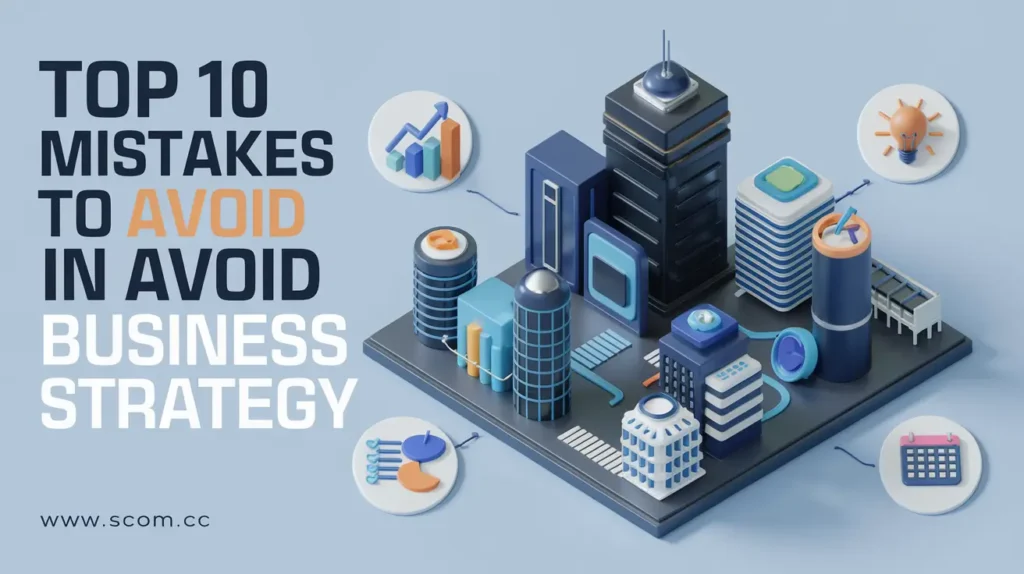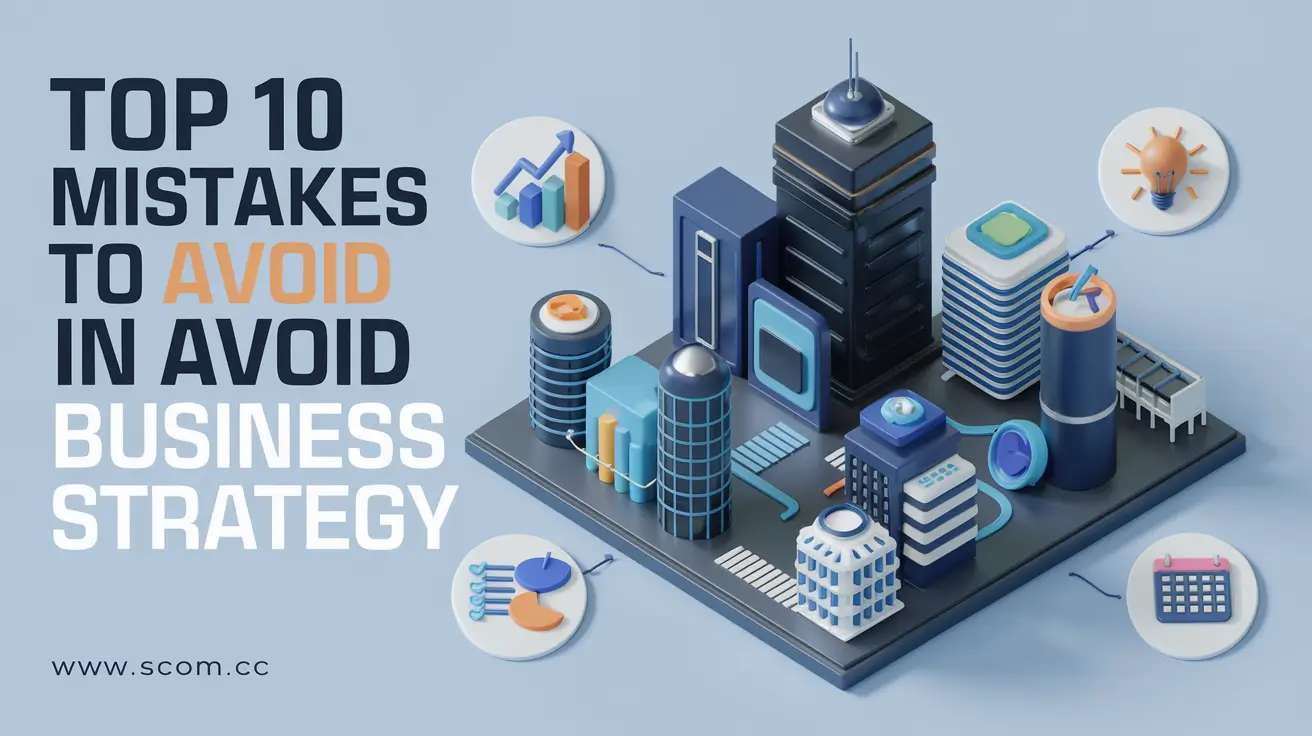Top 10 Mistakes to Avoid in Business Strategy

- Top 10 Mistakes to Avoid in Business Strategy
- 1. Failing to Define Clear Goals
- 2. Ignoring Market Research
- 3. Overlooking Competitive Analysis
- 4. Not Adapting to Market Changes
- 5. Underestimating the Importance of Execution
- 6. Neglecting Employee Engagement
- 7. Focusing Solely on Short-Term Gains
- 8. Ignoring Financial Constraints
- 9. Failing to Measure and Track Progress
- 10. Lack of Contingency Planning
- Conclusion: Crafting a Resilient Business Strategy
Top 10 Mistakes to Avoid in Business Strategy
Crafting an effective business strategy is crucial for long-term success, but even the most experienced leaders can fall into common traps. Missteps in strategic planning can lead to missed opportunities, wasted resources, and even business failure. To help you steer clear of these pitfalls, we’ve identified the top 10 mistakes to avoid in business strategy.
1. Failing to Define Clear Goals
A successful business strategy begins with well-defined goals. Without clear objectives, your strategy lacks direction, making it difficult to measure success or make informed decisions. Avoid vague or overly broad goals. Instead, set specific, measurable, achievable, relevant, and time-bound (SMART) objectives that guide your business toward a clear vision.
How to Avoid This Mistake:
- Develop a vision statement that outlines your long-term goals.
- Break down your vision into smaller, actionable objectives.
- Regularly review and adjust your goals as needed.
2. Ignoring Market Research
Market research is essential for understanding your target audience, competitors, and industry trends. Skipping this step can lead to misguided strategies that fail to resonate with customers or stand up against competitors.
How to Avoid This Mistake:
- Conduct thorough market research before finalizing your strategy.
- Continuously monitor market trends and adjust your strategy accordingly.
- Use customer feedback and data analytics to stay informed about your market.
3. Overlooking Competitive Analysis
Ignoring what your competitors are doing is a critical error. Failing to analyze the competition can leave you vulnerable to their strengths and blind to potential threats.
How to Avoid This Mistake:
- Regularly perform competitive analysis to understand your competitors' strengths, weaknesses, and market positioning.
- Identify what differentiates your business from competitors and build on those unique aspects.
- Stay informed about emerging competitors and industry disruptors.
4. Not Adapting to Market Changes
The business environment is constantly evolving. Sticking to a rigid strategy without adapting to market changes can lead to obsolescence. Flexibility is key to staying competitive.
How to Avoid This Mistake:
- Implement a strategy review process to assess your plan’s relevance regularly.
- Stay informed about industry trends, technological advancements, and changes in consumer behavior.
- Be willing to pivot when necessary to remain competitive.
5. Underestimating the Importance of Execution
A brilliant strategy is useless if it’s not executed effectively. Poor execution often stems from a lack of resources, unclear roles, or insufficient follow-through.
How to Avoid This Mistake:
- Develop a detailed action plan that outlines the steps needed to implement your strategy.
- Assign clear roles and responsibilities to ensure accountability.
- Monitor progress and make adjustments as needed to stay on track.
6. Neglecting Employee Engagement
Your employees are the ones who will execute your strategy, so failing to engage them can result in poor implementation and low morale. Employees need to understand and buy into the strategy to execute it effectively.
How to Avoid This Mistake:
- Communicate the strategy clearly to all employees and explain how their roles contribute to success.
- Involve employees in the strategic planning process to gain their insights and buy-in.
- Provide training and resources to support employees in executing the strategy.
7. Focusing Solely on Short-Term Gains
While short-term successes are important, focusing solely on immediate results can undermine long-term growth. A balanced strategy should consider both short-term objectives and long-term sustainability.
How to Avoid This Mistake:
- Create a balanced strategy that addresses both immediate needs and long-term goals.
- Allocate resources to innovation and development projects that will drive future growth.
- Continuously evaluate the impact of short-term decisions on your long-term strategy.
8. Ignoring Financial Constraints
Overambitious strategies that overlook financial realities can lead to cash flow problems, debt, and ultimately, business failure. It’s crucial to align your strategy with your financial capacity.
How to Avoid This Mistake:
- Develop a realistic budget that aligns with your strategic goals.
- Regularly review your financial performance and adjust your strategy if needed.
- Prioritize investments that offer the best return and align with your long-term objectives.
9. Failing to Measure and Track Progress
Without proper metrics, you can’t know whether your strategy is working. Failing to measure and track progress means missing out on opportunities for improvement and adjustment.
How to Avoid This Mistake:
- Establish key performance indicators (KPIs) that align with your strategic goals.
- Use data analytics to track progress and identify areas for improvement.
- Regularly review your KPIs and adjust your strategy based on the results.
10. Lack of Contingency Planning
Every strategy comes with risks, and failing to plan for potential setbacks can leave your business unprepared for challenges. Contingency planning is essential for mitigating risks and ensuring business continuity.
How to Avoid This Mistake:
- Identify potential risks and develop contingency plans to address them.
- Create a risk management framework that allows you to respond quickly to unexpected challenges.
- Regularly update your contingency plans as new risks emerge.
Conclusion: Crafting a Resilient Business Strategy
Avoiding these common mistakes is critical to developing a resilient and effective business strategy. By setting clear goals, conducting thorough research, staying adaptable, and ensuring strong execution, your business can navigate challenges and seize opportunities. A well-crafted strategy, free from these pitfalls, positions your business for sustained success in a competitive landscape.

If you enjoyed this article and found it valuable, we encourage you to explore our news and valuable information section, where you'll find more relevant and up-to-date content that may pique your interest. Additionally, if you are seeking advice or need guidance on a specific topic, we suggest visiting our services section. There, you will find a variety of options designed to assist and support you in addressing your needs. Feel free to check out both sections to get the information and assistance that best suits your requirements.

Leave a Reply